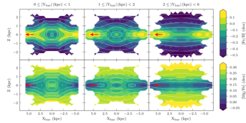A2A: 21 000 bulge stars from the ARGOS survey with stellar parameters on the APOGEE scale
Wylie, S. M., Gerhard, O., Ness, M. K., Clarke, J. P., Freeman, K. C., Bland-Hawthorn, J., 2021, A&A, 653, A143
In the last two decades Milky Way science has been revolutionised thanks in part to multiple large
spectroscopic surveys which have allowed astronomers to obtain precision parameters and
abundances for hundreds of thousands of stars across the Galaxy. However, each spectroscopic
survey is designed for unique science goals leading to differing observing and data processing
strategies. This results in different surveys being on different scales i.e. different surveys deriving
different parameters or abundances for the same stars. Because of this, different surveys should
not be combined. In this first part of Wylie et al. 2020, we use the data-driven method, The
Cannon, to recalibrate the iron abundances, magnesium abundances, temperatures, and gravities
of 21,000 stars from the ARGOS spectroscopic catalog to the scale of the much larger APOGEE
spectroscopic catalog. The recalibrated ARGOS catalog, the A2A catalog, could then be
combined with the APOGEE catalog. In the second part of Wylie et al. 2020, we use the APOGEE
and A2A catalogs to investigate the abundance structure of the Galactic bulge and bar. We find
that the iron and magnesium distributions are X-shaped and more pinched along the bar than the
density distribution. See Fig. 1 the metallicity and magnesium distributions on and off the Milky
Way’s bar built from A2A and APOGEE stars. We also see that the inner Milky Way has a clear
positive horizontal metallicity gradient along the bar such that the ends of the bar are more metal
rich than the Galactic centre (also visible in Fig. 1). Lastly we find that the iron-magnesium
distribution has two maximas that vary in strength with Galactic position: an iron-rich magnesium-
poor maximum and an iron-poor magnesium-rich maximum. Little kinematic dependence is seen
in the iron-rich maximum however as iron abundance decreases the rotation and dispersion
increase until -1 dex. In all, by comparing N-body models, Wylie et al. 2020 concludes that these
results support a multi-disk origin for the bulge and bar.

in the X-Z plane in slices of Y where X is along the bar’s major axis and Y is along the bars
minor axis. Both A2A and APOGEE stars were used to obtain these maps. The dotted white
lines follow the density distribution of a Portail et al. 2017 bulge-bar model. The red arrow
points in the direction of the Sun.
